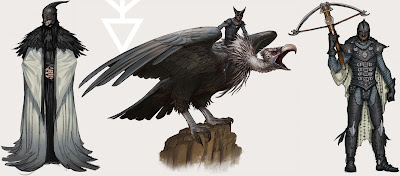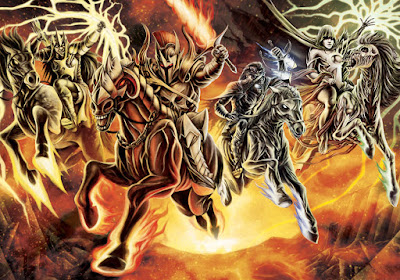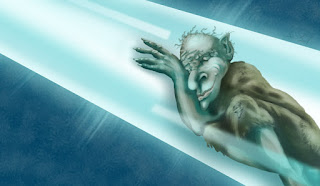 |
| There are big, tall, terrible giants in the sky! |
This was a pretty short game, we've all been pretty tired. There's a lot going on in the world to discuss, and inevitably when people gather the subject of politics comes up. I usually use a "No Politics at the Game Table" guideline, but it's been so omnipresent that it's becoming harder to avoid.
Sometimes as a DM it's easy to forget that your players are coming to your game not just to play, but to see people they haven't seen all week. They need time to chat, to relax, and to update each other on their lives. Your job as DM during this is to stop being a dungeon master for a few minutes and be a fellow human. Once everyone is settled, caught up, and usually fed, they can get into your game.
This story is part 4 of a series. This campaign was discontinued.
| Part 1 | Part 2 | Part 3 | Part 4 | Part 5 | Part 6 | Part 7 | Part 8 | Part 9 | Part 10 | Part 11 | Part 12 | Part 13 | Part 14 | Part 15 | Part 16 | Part 17 |
Storm King's Thunder: There are Giants in the Sky
 |
| The only Tower with a sense of fashion |
Jon: Dungeon Master
Megan: Cecelia Sondheim, human bard, a Harper hoping for a bright future!
Cody: Rolen Dundragon, half-elf Warlock of the Archfey, a scoundrel with a heart of gold
Cait: Mialee Galanodel, elf ranger, from a distant land and doesn't have personal space boundaries
When we last left off, the heroes had just finished saving the inhabitants of Nightstone from several different threats. The villagers decided that the best step forward would be to travel to Waterdeep, where they could rejoin society and get back on their feet. They were all very grateful to the group, and thanks to Cecelia, they had gained a high opinion of the Harpers.
They had been travelling along the High Road when a tower in the clouds appeared above them and lowered a set of cloudy stairs down to meet them. The tower looked to be hundreds of feet tall, with a spire that looked like a big, pointy wizard hat.
Mialee began to ascend the stairs without a second thought. Cecelia and Rolen hurried after, quickly assuring the villagers that they would be right back.
 |
| If ever a wonderful Wiz there was... |
He was looking for an elf of the Moonshae Isles, a man carrying a snake, and a girl with a heart of stone. The heroes quickly realized they were the three! Mialee is from Moonshae, Rolen carries a staff of the adder, and Cecelia's close encounter with the Dragon of Statues had left her chest partially changed to stone.
Zephyros said he had learned of great unrest among the giants in the world, and he had been casting "Contact other Plane" to figure out what he was supposed to do. The otherworldly entities had told him that he must help these three small folk get to where they were going, but not take a more direct hand in things.
The heroes quickly realized that he could save them a lot of time on their trip all the way up to Bryn Shander, to finish the quest that Morak Ur'Grey of Nightstone had given them. They were supposed to tell the sheriff of Bryn Shander, Markham Southwell, that his sister in Nightstone had died during a giant attack.
Rolen sent Rillix the Tressym flying down with a note to tell the villagers they were okay, and to continue on to Waterdeep. The villagers responded positively, especially since they had some of their own guards, and the High Road is one of the safest roads in the North.
 |
| A simple home for an eccentric wizard |
They also went up to the aerie, where Zephyros kept his pet griffons. They were quite tame and behaved a lot like cats, but Zephyros warned that they weren't trained to fly with humans on them. The party was very sad that there would be no griffon riding in this session.
Zephyros also told them that there was a new unrest among the giants. The social order that kept Giants in line, the Ordning, had been broken. Now, any giant could become the new lord of all giants. Many evil, ambitious giants had taken this call to heart, and started to put horrible schemes into place. This unrest was the reason Zephyros had reached out to the other planes in the first place.
 |
| It's every giant for themselves out there |
The discovery mechanic is fairly simple: whatever area the players are passing through has a discovery score. barren land has a score of 0, most places have a 1, forests, mountains, and other potentially dungeon-filled areas have a 2, and big ruins or ancient kingdoms have a 3 or higher. Each day, the players roll 1d6, and if they roll the Discovery score or lower, they see something in the distance. Of course, checking it out adds time to their journey, but here I wanted to show them some cool things they could find before actually putting them in a situation where they have limited time or resources.
On the third day of travel, the group suddenly saw an amazing sight: a massive wall, hanging in the sky. Zephyros suggested that this was likely another cloud giant castle, and he was a bit hesitant to check it out. He explained that cloud giant class structure is based on wealth and extravagance, and he'd never had much of a taste for such things. He wasn't sure how they would receive him.
As it turns out, they didn't receive him very well at all. Boulders began to pelt the tower as they approached, and Zephyros began to make magic shapes in the sky to try to signal they came in peace. The boulders stopped, but not before Mialee and Rolen were hit by flying rocks.
 |
| All that's missing is the "Go Away!" sign |
He also warned them to avoid his sister, Countess Sansuri, who had likely ordered the attack on Nightstone. She too had a scheme to become a new Lord of the Giants, which involved finding pieces of stone from the ancient Giant empire of Ostoria.
The characters took their leave, after the Count gave them a massive spell scroll containing the spell "Identify". It stood nearly as tall as Rolen, and Zephyros promised he would transcribe it to a smaller sheet for the warlock to use.
That evening, the party saw a group of nine shapes flying towards the tower. The party watched as nine humans on giant vultures landed on the cloud and began demanding to speak to the master of the tower.
The players were sufficiently shocked by this group - we had just played Princes of the Apocalypse, so they immediately recognized the Cult of Howling Hatred.
 |
| Oh dang, these guys again? |
Zephyros said he'd think about it, and wandered back inside to find the heroes eavesdropping just inside the door. After a quick discussion, the group convinced Zephyros that he shouldn't join up with the vulture-riding humans, and Zephyros went back outside to decline their offer.
The humans left peacefully, without taking the glowing bag back. Zephyros felt bad about keeping it, so he gave it to Rolen. Rolen immediately recognized it as pixie dust, from his tome of jokes that Hyrsam had bequeathed him. He blew a pinch of the dust into Mialee's face, and she disappeared!
They decided Mialee would make the best use of the pixie dust, which has a random effect if you sprinkle it over a creature. It was also very sparkly, which might have influenced their decision.
The tower continued its journey, passing over the Sword Mountains. Below they could see the roving bands of orcs and dwarven ruins. For the most part, they were content to stay up in the sky, well out of danger.
On the sixth day of travel, they discovered a breathtaking set of statues. A trio of massive dwarf statues, each holding a different weapon, carved into a mountainside over a thousand feet tall. On the middle dwarf there was a little hut, with smoke coming out of the top.
Despite Zephyros' worries, the group lowered the cloud stairs and headed down to the hut. It was a small place, with an animal skin flap serving as the door. They approached cautiously.
Suddenly, a loud, gruff voice barked at them to get inside, saying they were late. Lead by Mialee, they immediately went in.
 |
| What did you expect? Adonis? |
He explained that he was one of many oracles, which existed for every race, class, and many other philosophies. Mialee perked up when he spoke of the Oracle of Sex, but her spirits fell again when Bilk said he didn't know anything about where the other oracles were located.
Blik said he had a prophecy for each of them. If they followed the prophecy, they would find a powerful magical item they could use to fulfill their destinies.
Cecelia was told to go to Greypeak Mountains and look in "The Nest of the Lord of the Skies". Rolen was told to go "Under the Ocean, in the Court of a Friend". Mialee received the strangest prophecy, only being told that her item was "Once owned by a Long Dead King, who had the item Pulled from his Grasp."
The group asked if there was an item of power for Rillex, who was curled up on Rolen's shoulder. Blik seemed surprised, and told them he hadn't expected Rillex to want a prophecy too. Either way, he told Rillex that the item he sought was right there in Blik's hand, and gave Rillex some food.
Before the heroes could get comfortable, though, Blik shooed them out of his hut, saying they were already late and didn't have time to be lollygagging around here. They returned to Zephyros' Tower, hoping that the rest of their journey would pass quickly.
 |
| Because finding magic items is the goal of every campai- wait, is that A GUN? |
I'm still worried that the players will become less excited when they are gaining levels less quickly. This was the first game they didn't level up after, even though it was a short one. The module kind of expects you to spend a lot of time wandering around at level 6.
However, the saving grace here is that I have a subplot, the whole archfey thing, going on. Maybe the players can level up a bit more than expected? There are only three of them. Perhaps I'll put some big story beats in their travel games in order to keep the level-ups more consistent.
Thanks for reading!




































